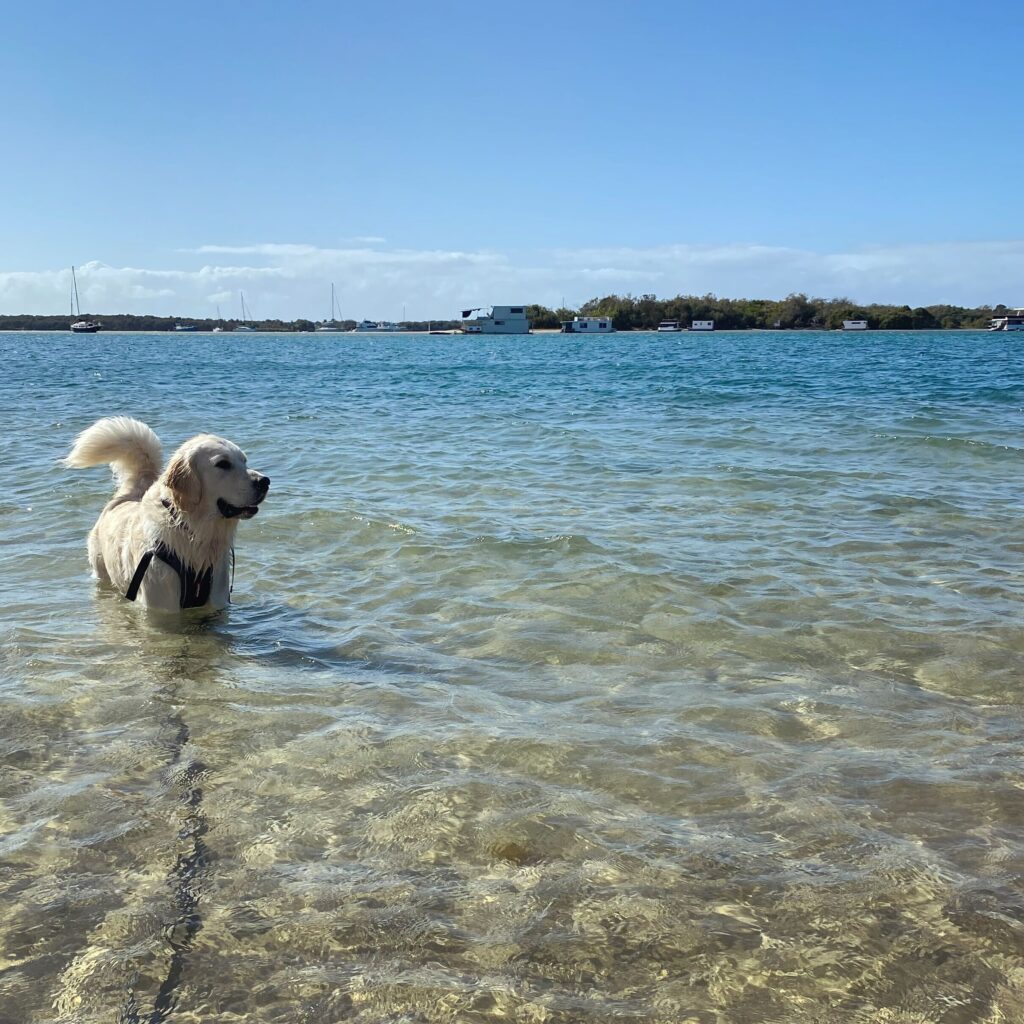As the summer sun graces us with its warm embrace, the idea of cooling off in the water becomes increasingly appealing—for both humans and their companions. The Gold Coast, renowned for having some of the best beaches and creeks in Australia, provides the perfect backdrop for enjoying the season. Why not make the most of it?
Dogs, known for their love of water, are natural swimmers, and exploring this aquatic world together can be a rewarding and enjoyable experience. In this blog post, we’ll delve into the art of dog swimming, uncovering the benefits, safety precautions, and tips to ensure a paw-some time for your canine companion.
The Natural Swimmers: Embracing Instincts
Dogs are born with an innate ability to swim, thanks to their evolutionary history and ancestors who navigated various terrains. While not every dog may be an Olympic swimmer, most can learn to paddle comfortably with the right introduction and positive reinforcement.
Some breeds are naturally great swimmers and will jump into any puddle they can find! Here are some breeds that love the water no matter what:
- Golden Retrievers
- Labradors
- Portuguese Waterdogs
- Irish Water Spaniel
- Chesapeake Bay Retriever
- Curly Coated Retriever
- English Setter
- Flat Coated Retriever
- Newfoundland
- Nova Scotia Duck Retriever
- Standard Poodle

If your dog’s breed isn’t on the list and he/she doesn’t love the water, don’t worry—they aren’t broken! Not every kid likes ice cream 🙂
On the other hand, some dogs might struggle in the water, either because they don’t have the fitness or their body conformation makes the exercise a lot harder. Long and skinny dogs like Greyhounds and Whippets, for example, have much less fat in their bodies and a very expansive body surface, making swimming an extra effort for them.
Deep-chested dogs like Bull Arabs, Rottweilers, Great Danes, etc., can also struggle to swim at first, as they are heavy on their front legs (especially with their heavy heads!). These guys need time and a slow introduction to build up their endurance until they feel very comfortable going in and out of the water.
What about cats?
Cats are known for not enjoying water on their fur, but there are a few kitties out there that don’t follow the rules (like most cats) and love a swim! Nathan, the beach cat, will show you how much he loves the water in this cool video.
Health Benefits of Dog Swimming: More Than Just Fun
Beyond the sheer joy of watching your furry friend frolic in the water, swimming offers numerous health benefits for dogs. It’s an excellent low-impact exercise that promotes cardiovascular health, builds muscle strength, and enhances flexibility. For dogs with arthritis or joint issues, swimming provides a therapeutic workout without putting stress on their joints.

Above all, playing in the water, being at the beach or in a pool, or even a small puddle, releases lots of endorphins and serotonin—the happy hormones! Exploring new places and being able to play with you brings connection and solidifies your relationship with them.
Introduction to Water: A Gradual Approach
If your dog is new to swimming, introduce them to water gradually. Begin in shallow, calm waters, allowing your pup to get comfortable with the sensation. Use positive reinforcement, treats, and gentle encouragement to create a positive association with water. Patience is key as your furry friend takes their first aquatic steps.
Never drag your dog into the water, especially if there are waves, no matter how small they are. Sometimes just going to the beach or a creek regularly makes them comfortable enough to start touching the water. Allowing them to explore the environment around them at their own pace is more beneficial than constantly trying to get them in the water.
Choosing the Right Location: Safe Havens for Doggy Paddling

Selecting the right swimming spot is crucial for a positive experience. Look for calm, shallow waters with minimal currents. A designated dog-friendly beach, a swimming pool, or a calm lake can be ideal choices. Avoid areas with strong currents, choppy waters, or hidden hazards that may pose risks to your dog’s safety.
Also, avoid times and locations with many dogs, as it can be overwhelming for your dog, or they can be easily distracted. Instead, try to find specific spots or times of the day that will be calmer, allowing you to enjoy a peaceful walk without other stressors.
Life Jackets: A Stylish Safety Accessory
Even if your dog is a confident swimmer, investing in a well-fitted life jacket is a wise precaution, especially if you plan to venture into deeper waters or embark on boat trips. Life jackets provide buoyancy, ensuring your dog stays afloat in case of fatigue or unexpected challenges. Choose a brightly colored jacket for visibility, and always supervise your pup while they’re wearing it.
Remember that even though your dog is a great swimmer, they do not always plan their activities in the water! They might be able to comfortably swim towards you or a toy, but they can get pulled by a current or get a muscle cramp or become fatigued and quickly drown. Rescuing a dog from deep waters can be difficult and frustrating—dogs don’t necessarily understand they can stop paddling when you catch them, so you can get injured when trying to pull them out of the water.
Water-Friendly Games: Turning Splashes into Smiles
 Make dog swimming sessions more engaging by introducing water-friendly toys. Floating toys, retrieving games, and interactive play can turn a simple swim into an exciting adventure for your pup. Be cautious with toys that sink or may become hazardous in the water, and always monitor your dog’s playtime to ensure their safety.
Make dog swimming sessions more engaging by introducing water-friendly toys. Floating toys, retrieving games, and interactive play can turn a simple swim into an exciting adventure for your pup. Be cautious with toys that sink or may become hazardous in the water, and always monitor your dog’s playtime to ensure their safety.
Always remember to give them fresh water regularly to dilute all the saltwater they ingest when catching toys. Saltwater toxicity is an emergency that needs medical intervention and can be deadly, especially if your pup was already dehydrated during the swimming session.
Post-Swim Care: Drying Off and Hydration
After an invigorating swim, ensure your dog’s coat is thoroughly washed and dried off to prevent skin issues. It is essential to remove the salt from their skin to prevent dermatitis or other serious damage to their skin.
Towel-dry their fur and pay attention to their ears, ensuring they are dry to prevent infections. Wet fur is a common cause of hot spots, a superficial bacterial infection on the skin that can be triggered due to excessive moisture on the skin.
Safety First: Awareness and Supervision

As with any outdoor activity, safety should be a top priority. Always supervise your dog while they swim, even if they are experienced paddlers. Keep an eye out for signs of fatigue, distress, or any potential hazards in the water. Having a leash on hand can be useful, especially in unfamiliar locations or situations where additional control is needed.
You can use a long lead to help you always have control of your dog. This allows them to be secure to you at all times, in case you need to get them out of troubles!
Health Check: Vet Visits and Regular Monitoring
Before diving into regular swimming activities, consult with your veterinarian to ensure your dog is physically fit for this form of exercise. Certain health conditions may warrant limitations or modifications to their swimming routine. Regular check-ups will help monitor your dog’s overall health and address any concerns that may arise.
Dog swimming is more than just a delightful pastime—it’s a fantastic way to keep your furry friend active, healthy, and happy. By following these tips and embracing the joys of canine aquatics, you’ll create lasting memories of shared adventures and strengthen the bond between you and your loyal companion. So, grab your towels, pack some treats, and get ready to make a splash with your furry friend this summer!